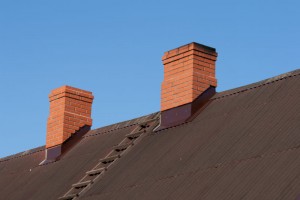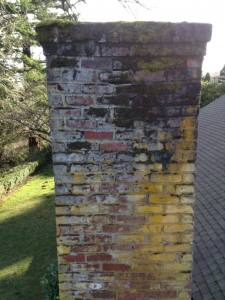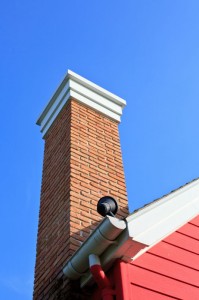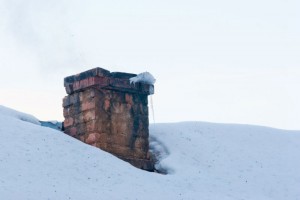by Billy Sweet | Mar 10, 2015 | Chimney Flashing
The bad news is that your roof may leak from time to time, especially after heavy rain or snowfall. The good news is that often the repair is as simple as replacing the flashing, rather than replacing the entire roof. Chimney flashing is not a shingle, but rather a detail that is installed in order to seal the joints that connect the roof to the chimney. These joints are not water tight, so thorough, professionally installed chimney flashing will help keep water away from your chimney. The result is not only a dry chimney, but also a dry and protected home interior.

Types Of Chimney Flashing
There are a few different types of chimney flashing. Aluminum is common and inexpensive, however it is susceptible to corrosion, so it may need to be replaced every so often. Vinyl is another popular choice because it is still affordable but not as durable as other materials. Vinyl can become brittle and crack under harsh weather conditions and like aluminum will probably need to be replaced. On the other hand, steel is more expensive and takes longer to install, but is one of the more durable choices because it will not corrode. Similarly, copper flashing is the most widely recommended material for flashing because it will not corrode or crack but is lightweight like vinyl. Keep in mind, copper is the more expensive option, but after initial installation copper will not need to be replaced and will likely last as long as your roof.
Without Flashing You Can Damage Your Chimney
As a homeowner, if you are wondering whether or not flashing is important, let us save you some time. Flashing is very important! Without proper protection from external elements, your chimney could be vulnerable to water damage. Chimneys are made from brick and concrete, and if exposed to rain and snowfall over time, these materials can chip, crack and crumble. The result is almost always expensive chimney repairs that could have been avoided. If you do not install proper flashing you could be damaging your roof, and leaving your ceilings and wall treatments susceptible to leaks. Flashing is a simple and necessary installation that can save you a lot of homeowner headaches.
It is important to install flashing, but it is equally important to have your chimney inspected to make sure your chimney flashing is doing its job. Depending on the materials used in initial installation, the flashing material could have been damaged, or the joints could have loosened, which is why it is so important to have your chimney regularly inspected by a professional inspection company.
Always Have A Professional Install Your Chimney Flashing
Installing flashing is a task that is best left to the professionals. The experts at Billy Sweet Chimney Sweep in Boston have years of experience inspecting chimneys and making sure flashing is installed properly. If you attempt to install your own flashing you run the risk of installing it incorrectly as well as injuring yourself in the process. Trust the experts to help you maintain your home and recommend the chimney flashing products that are right for your chimney and right for your home maintenance budget.
by Billy Sweet | Nov 30, 2014 | Full Chimney Rebuild
All parts of a home will eventually need an upgrade because time wears down everything. Older homes, which are very common all along the east coast, generally need these updates sooner rather than later. Everything from contemporary style updates to energy savings updates can help bring an older home into the modern world. For homeowners looking ahead to the chilly winter, an update to the chimney or fireplace may be next on the to-do list.

Chimneys can require a rebuild for a number of reasons, but the most common issue involves a partial or complete collapse of the chimney. Collapse occurs when the structure of the chimney has degraded, often due to long term exposure to harsh weather. Masonry chimneys, in particular, can suffer negative effects from weather. The materials used to construct a masonry chimney – brick, concrete, and mortar – all have a very porous nature, meaning they readily absorb water. Absorbing water alone does not have damaging consequences, but when the temperatures drop below freezing, the issues begin. In freezing weather, water undergoes a freeze and thaw cycle in which it continually expands and contracts. The bricks and concrete saturated with water also contract and expand with the water inside, and this results in degraded materials over time. First, the mortar will crack and fall from between the bricks, and the concrete will split. Then, the bricks come loose, and the entire structure loses its integrity. Eventually, the chimney could collapse.
Other problems that may result in a chimney rebuild include earthquakes and chimney fires. Earthquakes can cause irreparable structural damage to the chimney, and older chimneys usually do not have the stabilizing steel rebar that modern chimneys use to protect against this type of impact damage. The rebuilt masonry chimney would contain this rebar to stabilize the structure in case of future earthquakes. Chimney fires can also necessitate a rebuild, especially with older masonry chimneys. These chimneys often utilized clay or mortar chimney liners, which crack and split under the heat of the fire. This destroys the protection provided by the chimney liner and undermines the strength of the structure overall.
While a full chimney rebuild may not seem ideal from the homeowner’s point of view, if only for the cost of it, this process could mean the difference between a safe fireplace and a hazardous one. In order to make the rebuild process easy and effective, a chimney expert must be employed. This ensures proper and safe construction that meets safety codes. If you live in the area of Boston or North Shore, Massachusetts or near Portland, Maine, you can get in contact with Billy Sweet Chimney Sweep for a rebuild inspection and consultation.
by Billy Sweet | Oct 15, 2014 | Masonry Chimney
The autumn weather has arrived in full force. The chilly wind has colorful leaves falling from the trees and has everyone digging up their cozy jackets. This time of year also has homeowners thinking about how to heat their homes. In the frigid New England winters, this is a big concern. Many homes utilize fireplaces for some or even all of their heating needs. With a fireplace, however, comes some maintenance responsibilities. Fireplaces with masonry chimneys, in particular, are prone to specific types of issues, so you need to keep an eye out for the safety of your home and family.

A major issue that masonry chimneys face is water damage. Many homeowners never even consider that their strong, robust chimney could ever succumb to damage from a little water. Chimneys are built to live outside, after all. Unfortunately though, water can cause serious problems. The materials used to build a masonry chimney like brick, mortar, and concrete are all very porous, meaning they readily absorb water. While stones do not absorb water, the mortar holding them together does. The trouble with a masonry chimney filled with water occurs during the freeze and thaw cycles of winter. The water expands as it freezes, which means the bricks, the mortar, and the concrete all expand as well. Over time, this expansion causes damage.
You may see water damage in several different forms. The first clue is cracked or missing mortar. The constant movement of the materials during freezing weather loosens the bonds of the mortar. Thus, the mortar wiggles its way out from between the bricks, appearing as a crack or as a decent sized hole. A mason can usually fix isolated mortar cracks or holes using a process called tuckpointing.
Another sign of water damage is a cracked chimney crown. This concrete slab on top of your chimney acts as an umbrella to keep water from entering the flue. If it has cracks from water damage, water is entering your chimney, which leads to a whole new set of problems. Ask your mason if he can patch the cracks. Otherwise, the chimney crown may need to be completely replaced.
The most devastating sign of water damage to the chimney is partial or total collapse of the structure. This most likely occurs after years of exposure to water and freezing temperatures, but a poorly built chimney could suffer from collapse in less time. Chimneys are very heavy, meaning a collapse could be a danger to anyone on the ground and to the structure of your home. Any signs of a collapsing chimney must be addressed by a mason right away.
Luckily, you can take some steps to prevent water damage, like sealing your chimney and adding a chimney crown. Ask your mason what can be done to protect your chimney. If you live in the Boston or North Shore area or around Portland, Maine, contact Billy Sweet Chimney Sweep for a professional consultation. The experts at Billy Sweet Chimney Sweep can help make your chimney last for many more years.
by Billy Sweet | Sep 15, 2014 | Chimney Maintenance
Your beautiful fireplace has always come through for you. It faithfully heats your home during brutal New England winters and creates a tranquil setting on a snowy evening. Even during the summer, the fireplace acts as a majestic focal point in your home. In fact, the fireplace may be credited with helping to convince you to purchase the home in the first place.

If you want to enjoy your fireplace for years to come, it will need proper maintenance. Most people have the chimney swept every year, which is a good practice but often not enough. The majority of homeowners neglect one piece of chimney care that might result in thousands of dollars in damage: winter effects.
With a masonry chimney, the exterior construction will consist of any material such as brick, stone, mortar or concrete. Additionally, the internal materials may include steel, cast iron or flue tile. Your chimney has some combination of these and each one, except stone, can experience damage after years of exposure to cold, snowy winters.
Brick, mortar and concrete are all very porous materials and will readily absorb water, which includes melted snow as well. When these waterlogged materials go through the freeze and thaw cycle of winter, they also undergo needless distress. This stress inevitably expands and weakens the structure, which leads to cracks or even collapse. While stone is immune to the freeze and thaw stress, if your chimney is made of stone, you still need to watch for water damage. The mortar securing the stones experiences the damages of freezing and needs inspection and repairs even if the stone is unharmed.
The melted snow can also leak inside the chimney, where the steel flue will rust. Now, water can infiltrate the inside of the masonry, which means further damage. If the water travels down the chimney, the damper apparatus eventually rusts, so the fireplace may fail to vent properly. The water may go on to cause more damage such as rusted fireplace face and doors, deteriorated hearth, and soaked ceilings or walls around the fireplace.
The cost of preventing these damages is much more reasonable than paying for the repairs. To properly prevent water damage from melted snow, you have a few options.
Water will first enter the chimney through the top. Having a chimney service install a chimney cap is a great, inexpensive way to prevent interior water damage. Some masonry chimneys also have a structure known as a crown. This concrete slab acts as a roof for the chimney to prevent water from leaking inside. Over time, the concrete will crack, so the crown may require patching or complete replacement to ensure proper water resistance. Another part of the chimney that may leak is the flashing, or the aluminum cover that seals the seam where the chimney protrudes through the roof. The flashing is sealed with tar, which may simply need to be redone. A good way to protect the outside of the chimney is to have a chimney service apply a sealant. The vapor-permeable sealant allows moisture to escape but prevent exterior water from entering the porous materials.
If you live in the areas of Boston, Massachusetts; Portland, Maine, or North Shore, contact Billy Sweet Chimney Sweep for a professional consultation. These experts will ensure your chimney and fireplace will hold up for many more winters to come.
by Billy Sweet | Jul 22, 2014 | Chimney Maintenance, chimney sweep, damaged chimney, damaged masonry, spalling, Uncategorized
Did you know your chimney could sweat? Did you know that this process is actually very harmful to your chimney? Well now that it has been brought up, you must learn all the facts. When the bricks of your chimney sweat, spalling can start to occur. If you feel like this could be happening with your chimney, call the professionals at Billy Sweet Chimney Sweep.
What is chimney spalling and how is it caused?

Spalling is what happens when the bricks or stones on your masonry chimney start to come off in flakes or start to go missing because of water penetration. One of the first signs is when you find random bricks on the ground or on your roof. Often times the main cause of spalling is when the water absorbed in the bricks from precipitation freezes and thaws. This can be worsened by the condensation of flue gases in liners that are not the right size, or gaps and cracks in the interior mortar joints. Also, spalling is made more prominent when extra water enters the interior by way of the chimney chase. Softer types of bricks are more likely to have moisture penetration, but are often used over harder types of bricks because they are more cost-friendly.
The chimney will be one of the first places that will show that it has damage since it is constantly exposed to the elements. The spalling will start with the top portions but once one part of the chimney starts to spall the whole inside has already been damaged. These bricks must be replaced since they are permanently damaged.
How can you prevent spalling?
There is no complete way to protect your chimney from water damage, but there are a few things that you can do to help. First, you need to have your chimney waterproofed. Your chimney technician can do that on any dry day after they sweep. The layer of sealant will need about six hours to dry so it is important to plan ahead. If you live somewhere where it rains often, you might look into having a second coat applied. Chimney caps are also another great way to help keep water out, as well as animals and leaves, but must be properly installed to be safe.





